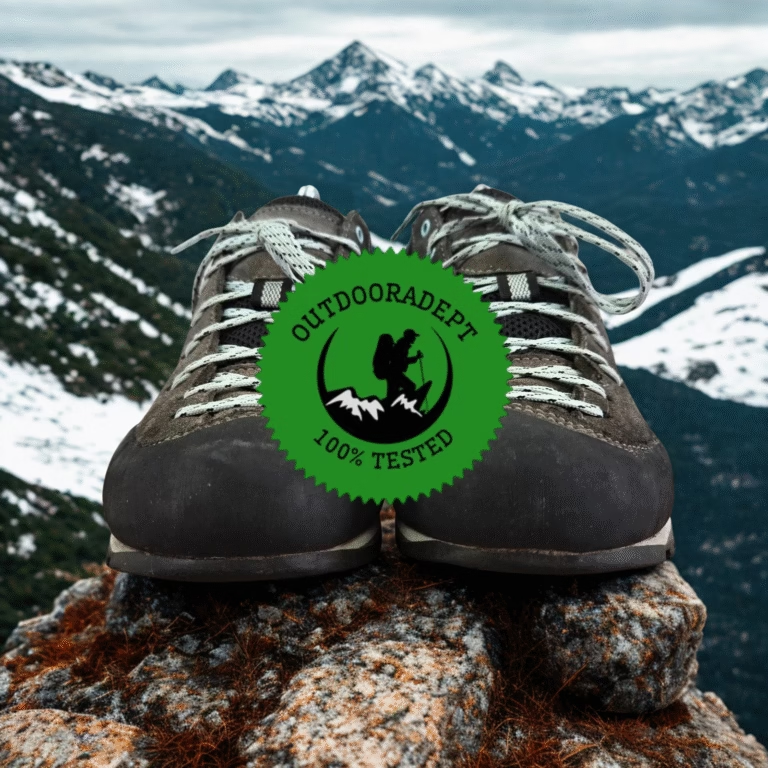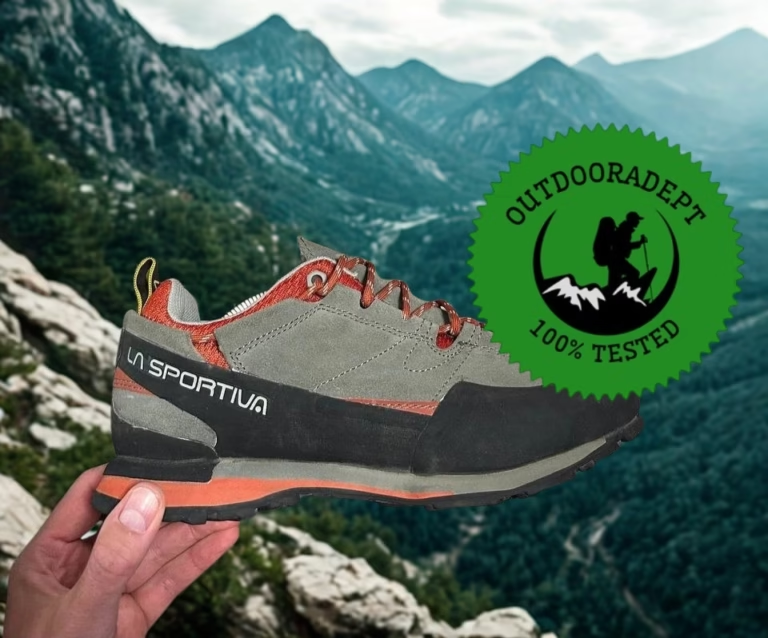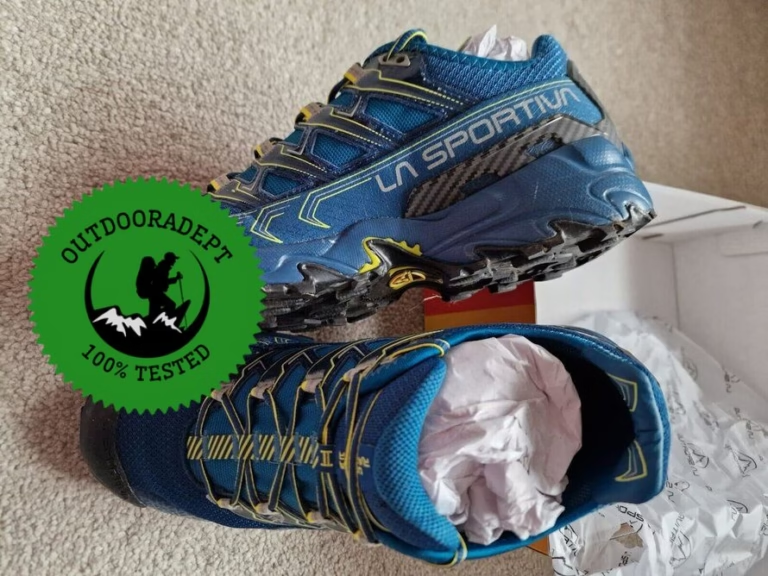La Sportiva has been my go-to brand since 2017. Started with the Bushido trail runners – loved those things. Eventually made the jump to their TX line, and the TX3 became my main shoe for a solid two years.
However, I kept shredding the mesh on the sharp volcanic stuff we have around here, so I figured it was time to try something more durable. This is how I ended up with the TX4 Evo.
I’ve put about six weeks on these now, including a pretty brutal summit push on Mount Kinabalu in Malaysia and some gnarly scrambles on Vietnam’s Fansipan Trek.
Our Verdict
The TX4 Evo handled everything I threw at them: wet granite, loose scree, you name it.
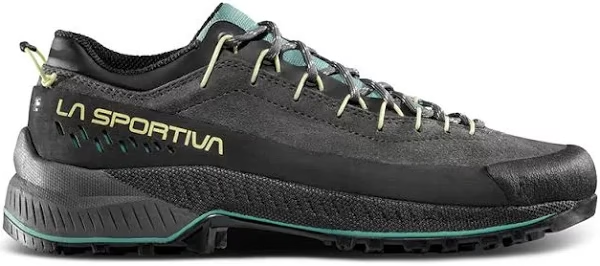
Never felt sketchy once, though I’ll admit the weight takes some getting used to, especially on easier terrain where you’re just eating miles.
They’re heavier than the TX3 (about 1 lb. 8 oz), but it’s worth it. That Vibram Megagrip sole is great on technical rock. And the toe box is just wide enough without being sloppy, which my feet really appreciate after 8+ hours.
Let me break down everything else I noticed.
Highlights
| Feature | La Sportiva TX4 Evo |
|---|---|
| Weight | Men’s: ~1 lb. 10 oz (≈ 740 g) per pair, US 9 Women’s: ~1 lb. 7 oz (≈ 660 g) per pair, US 7 |
| Water Resistance | Water-resistant nubuck leather upper; not fully waterproof |
| Traction | Vibram® Megagrip outsole with Impact Brake System and climbing zone; excellent grip on rock and mixed terrain |
| Comfort | MEMlex midsole with 4 mm Ortholite footbed; stable, firm cushioning for long approaches |
| Adjustability | Mythos-style lacing extends to the toe for a precise, customizable fit |
| Breathability | Moderate; better than waterproof boots but warmer than mesh shoes |
| Durability | Full leather upper with rubber rand; exceptionally abrasion-resistant and long-lasting |
| Support | STB Control System with TPU shank; outstanding torsional stability for heavy loads |
| Toe Protection | Full rubber toe cap; reliable protection on rocky and technical routes |
Pros & Cons
PROS
CONS
Things We Tested When We Reviewed La Sportiva TX4 Evo
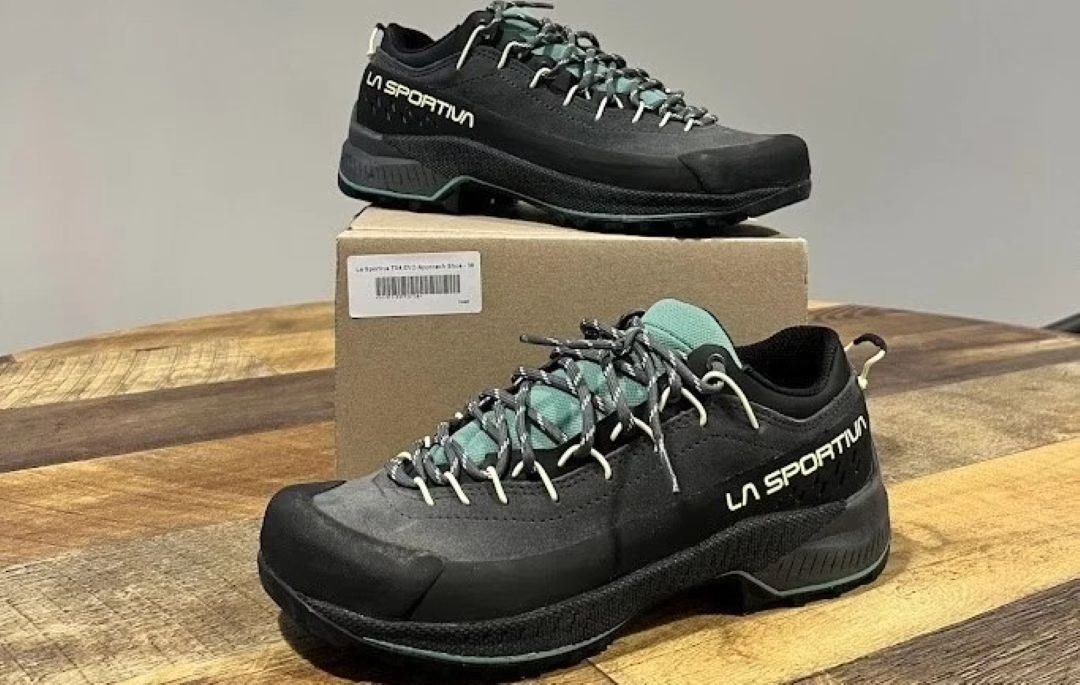
Traction
The Vibram Megagrip compound on these approach shoes delivers a confidence-inspiring grip that honestly surprised me.

On Kinabalu’s polished granite slabs, slick with morning condensation, the 3mm lugs and smooth climbing zone under the toe gave me purchase where my old trail runners would’ve had me sketching.
The rounded lug pattern clears mud quickly, which mattered on Fansipan’s clay-heavy descents after afternoon rains. What I really liked was the Impact Brake System at the heel – steep downhills that usually have me slipping and sliding felt noticeably more controlled.
The dotty tread grips variable terrain well, though the shallow lugs don’t bite into steep grass like full hiking boots. During stream crossings, the sticky rubber held on algae-covered stones better than expected.
And that climbing zone? Excellent. On Kinabalu’s exposed Via Ferrata sections, I could smear confidently on quarter-inch edges.
It’s not quite climbing shoe territory, but it’s remarkably close for something you can hike in comfortably.
Durability
After six weeks of aggressive use, my TX4 Evos show minimal wear, and that’s saying something given the punishment I dished out. The nubuck leather upper has some character marks from volcanic rock, but zero tears or separations.
The PU TechLite rand wrapping the base proved its worth repeatedly. Jamming my feet into cracks during scrambles, kicking steps in steep terrain, and generally treating these shoes roughly haven’t compromised the protection.
The rubber toe cap remains intact without delamination. The Vibram sole still has about 75% of its tread remaining, which suggests these’ll last significantly longer than advertised. I did replace the laces once – the originals frayed faster than I’d like for a $189 shoe. But the metal eyelets at the top three holes are holding strong.
Comfort
Breaking in leather approach shoes typically involves some suffering, but the TX4 Evo surprised me. After about 15 miles, the nubuck had conformed nicely to my foot shape without the blisters I’d anticipated.
The toe box is reasonably wide and allows your toes to splay naturally, which matters enormously when your feet swell after eight hours on trail. That said, it’s not as roomy as the previous TX4 version. In fact, my experience showed that the Evo feels narrower up front.
The 4mm Ortholite footbed provides decent cushioning, though don’t expect plush trail runner levels of padding. This is a firm platform designed for stability over softness. On rocky descents, I felt more ground feedback than with heavily cushioned shoes, which led to mild fatigue on extra-long days.
That stiffness can feel overbuilt on smooth trails, yet it’s an asset when terrain turns technical, providing a solid base. The padded tongue keeps lace pressure at bay, and the snug heel cup locks the foot in securely.
Breathability
Leather approach shoes and Southeast Asian heat don’t mix perfectly, and the TX4 Evo proved that point.

In hindsight, testing them in the jungle probably wasn’t my smartest move.
On Fansipan’s humid climbs, my feet ran much warmer than they would’ve in mesh shoes. The nubuck breathes better than waterproof synthetics, but it’s still leather. During breaks, I often pulled them off just to cool down, a routine I never had with the TX3.
At higher, cooler sections like Kinabalu’s 3,200 m ridge, breathability felt fine. The leather regulated temperature better than expected and kept moisture in check. But once temperatures hit 30 °C with jungle humidity, ventilation fell short.
The non-GTX version helps, yet in tropical heat, I still found myself wishing for the TX3’s mesh upper. Perfectly suited to temperate mountain use, not steamy rainforest.
Weight
At 1 lb. 8 oz for my women’s size 8, these aren’t lightweight by modern standards. After carrying them up several thousand meters of elevation gain, I definitely noticed those extra ounces compared to trail runners.
When I clip them to my harness for multi-pitch routes, the weight is substantial enough that I usually opt for lighter alternatives. However, context matters. This weight comes from thick leather, a burly midsole, generous rubber protection, and a stiff support platform.
The TX4 Evo weighs about 4 ounces more per pair than the mesh TX3, which seems like a fair trade for the durability upgrade. Compared to the ultralight TX2 at 1 lb. 2.6 oz, the difference is more significant, but those shoes serve different purposes.
For approaches with camera gear or camping equipment, the TX4 Evo’s weight feels justified.
Waterproofing
La Sportiva doesn’t claim these are waterproof, and they’re not, but the nubuck leather does a better job than I expected. There’s this stream crossing on Fansipan where you’re basically wading shin-deep, and my feet actually stayed dry for maybe the first 20 minutes after.

The leather sheds water pretty well when you keep up with the treatment, and the shoe sits high enough that you can plow through shallow puddles without issue.
Heavy rain is a different story, though. After four hours of downpour on Kinabalu’s descent, the leather eventually became saturated, and my feet got wet. That’s expected for non-Gore-Tex shoes. Leather will wet out eventually.
What impressed me was how quickly they dried afterward. Stuffed with newspaper overnight, they were ready by morning.
I’ve been maintaining the leather with Nikwax Leather Wax every few weeks, which noticeably improves water resistance. Untreated leather will soak through faster.
Support
The support in these approach shoes was among the best I’d experienced in low-cut footwear. The STB Control System, with its TPU shank, provides serious torsional rigidity, which prevents excessive midfoot twisting on uneven terrain.
When I carried a 30 lb. pack up Kinabalu’s rocky sections, the stiff platform kept my foot stable and aligned, reducing ankle strain significantly.
The Traverse-injected MEMlex midsole felt more like a lightweight boot than a flexible trail runner. On talus fields and boulder hops, the shoe didn’t collapse or twist when I stood on off-camber rocks.
The wide base in the forefoot increased stability, too. I could edge precisely on small holds without the shoe bending or rolling.
For carrying heavy loads into the backcountry, this was the most supportive approach shoe I’d tested. It rivalled entry-level mountaineering boots.
Fit and Sizing
Sizing the TX4 Evo requires attention because it runs large and has a unique fit. I normally wear a US women’s 8.5 in most brands, but I sized down to an 8 in these, and they fit perfectly.
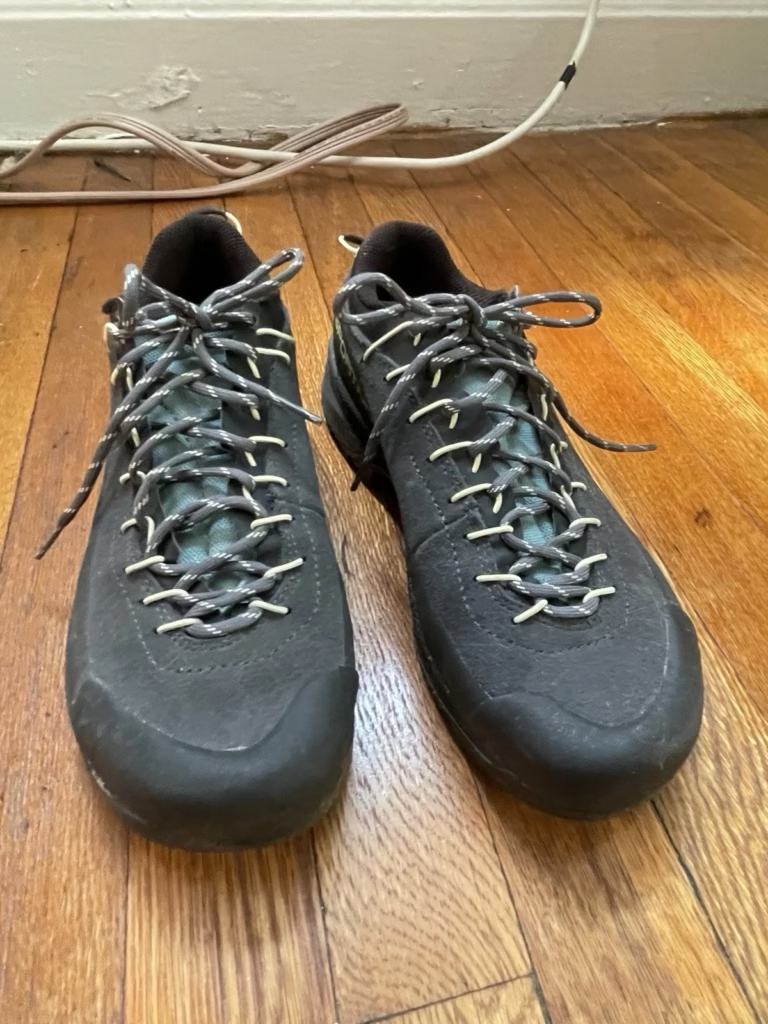
Most reviewers recommend going a half size down from your normal shoe size, contrary to La Sportiva’s official guidance.
The fit is characterized by a reasonably wide toe box, which I absolutely love. My toes can splay naturally, and at the end of long days when my feet swell, there’s still adequate room.
The midfoot and heel are narrower and more secure, creating an unusual but effective shape. If you have narrow or low-volume feet, you might find the TX4 Evo too roomy.
Yet, if you loved the original TX4 specifically for its exceptionally wide toe box, be aware the Evo has a more performance-oriented, slightly narrower fit.
How Does it Compare with Other Products?
La Sportiva TX Guide
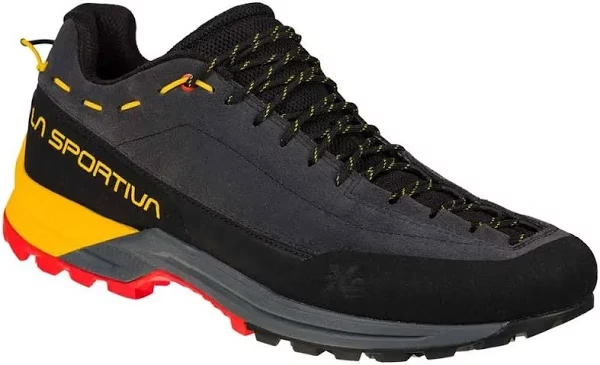
The TX Guide is built for climbers who need precision over comfort. Narrower last, tighter toe box, great for edging on technical rock, pretty miserable after a few miles.
The mesh breathes way better than the TX4’s leather, but tears more easily and offers zero weather protection. It’s lighter by about 3 ounces (1 lb. 5.5 oz), which matters if you’re clipping shoes to your harness.
Traction’s identical – both use Vibram Megagrip. But the TX Guide feels less stable under a heavy pack.
Bottom line: if you’re primarily climbing, grab the TX Guide. For mixing long approaches with scrambles, the TX4 Evo’s versatility wins.
Learn more about this product in our La Sportiva TX Guide Review.
Scarpa Mescalito Planet
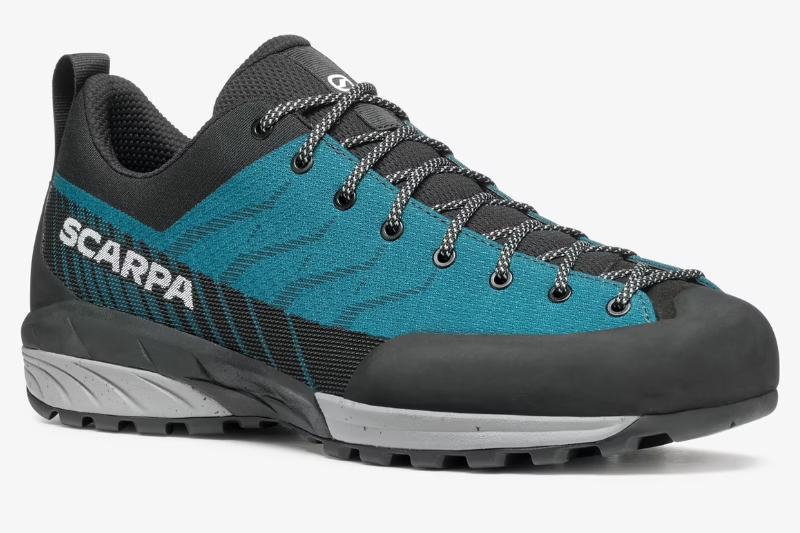
The Mescalito Planet competes directly with the TX4 Evo, offering similar leather construction and approach shoe versatility. It accommodates wider feet better, which matters if La Sportiva’s sizing doesn’t work for you.
The Scarpa uses Vibram Dynamis compound on a Presa sole, which is slightly less sticky than Megagrip but still good. Build quality feels comparable, with full leather uppers and protective rubber rands.
The fit runs truer to size without the TX4 Evo’s quirky large-then-narrow pattern. Cushioning feels similar underfoot, though some reviewers find the Mescalito slightly more flexible.
Scarpa Crux
The Crux is the budget play at $139, fifty bucks cheaper than the TX4 Evo. It’s got this leather-synthetic hybrid upper that breathes better and weighs less, but you’re giving up some protection. The Vibram sole grips decently, just not quite at Megagrip level.

Build quality is where you notice the price difference. It’s fine, but definitely not as burly.
They’re more flexible, though, which is nice on mellow trails. Just don’t expect much support with a loaded pack or on gnarly terrain.
If you’re new to approach shoes and want to dip your toes in without dropping serious cash, the Crux is solid. But if you’re actually using these in the mountains regularly, spend the extra fifty. The TX4 Evo’s durability and support are worth it.
For more details of this approach shoe, check out our review of the Scarpa Crux.
Where La Sportiva TX4 Evo Performs Better
The TX4 Evo excels on technical alpine approaches where you’re mixing hiking with scrambling and need footwear that handles both confidently. Think fourth-class terrain, via ferratas, boulder fields, and talus slopes where precision matters.
It’s ideal for multi-day mountain objectives carrying heavy packs. The support and stability shine when you’ve got 40lb on your back, navigating unstable ground. Shoulder-season conditions with variable weather favor the leather’s water resistance and protection.
If you’re a mountain guide or frequent scrambler who needs durable rock-climbing gear that won’t fail after a season, the TX4 Evo delivers. It’s also great for alpine rock-climbing approaches where the descent involves technical terrain, and you can’t just wear flip-flops back down.
Where La Sportiva TX4 Evo Falls Short in Performance
These aren’t the shoes for fast-and-light trail running or long days on smooth, established trails where their stiffness and weight feel excessive. Hot, humid climates expose the leather’s limited breathability. I’d choose mesh alternatives for tropical or desert conditions.
The wide fit works for most feet, but can feel sloppy if you have narrow or low-volume feet. At 1 lb. 8 oz, they’re too heavy to comfortably carry on your harness for multi-pitch rock climbing unless you specifically need them for the descent.
The maintenance requirements (treating leather regularly, replacing laces) add hassle compared to synthetic shoes.
Do We Recommend La Sportiva TX4 Evo?
My experience testing these on demanding Asian peaks proved their worth for technical mountain terrain. The exceptional traction, bomber durability, and support make them excellent approach shoes for serious alpine use.
The reasonably wide toe box provides rare all-day comfort in this category. However, they’re heavy, run warm, and require maintenance.
Size down a half size and verify the fit works for your foot shape before committing. If you primarily hike mellow trails, lighter options exist.
But for scrambling, via ferratas, technical approaches, and mixed terrain with heavy loads, the TX4 Evo delivers genuine capability that justifies the investment.
Where to Buy It?
| WHERE TO BUY? | MEN | WOMEN |
| Amazon | See Pricing» | N/A |
| Backcountry | See Pricing» | See Pricing» |
| REI | See Pricing» | See Pricing» |
FAQs
The TX4 Evo is a low-cut leather approach shoe designed for scrambling and technical hikes, while the TX5 is a mid-cut, Gore-Tex-equipped boot offering more ankle support and weather protection for heavier loads and longer treks.
Yes. The La Sportiva TX4 Evo features a durable Vibram Megagrip sole and patented Resole Platform technology that makes it especially easy to resole through La Sportiva’s authorized repair program or qualified cobblers, significantly extending the shoe’s lifespan with proper maintenance.






